Case Studies: Michael Lee-Chin Crystal ROM and Denver Art Museum
VerifiedAdded on 2023/06/11
|13
|1244
|183
AI Summary
This article presents case studies on the architecture, framing, foundation, curtain walls, building technology, and materials used in Michael Lee-Chin Crystal ROM and Denver Art Museum. It also covers the structural components, supports, and any environmental initiatives considered during the construction.
Contribute Materials
Your contribution can guide someone’s learning journey. Share your
documents today.
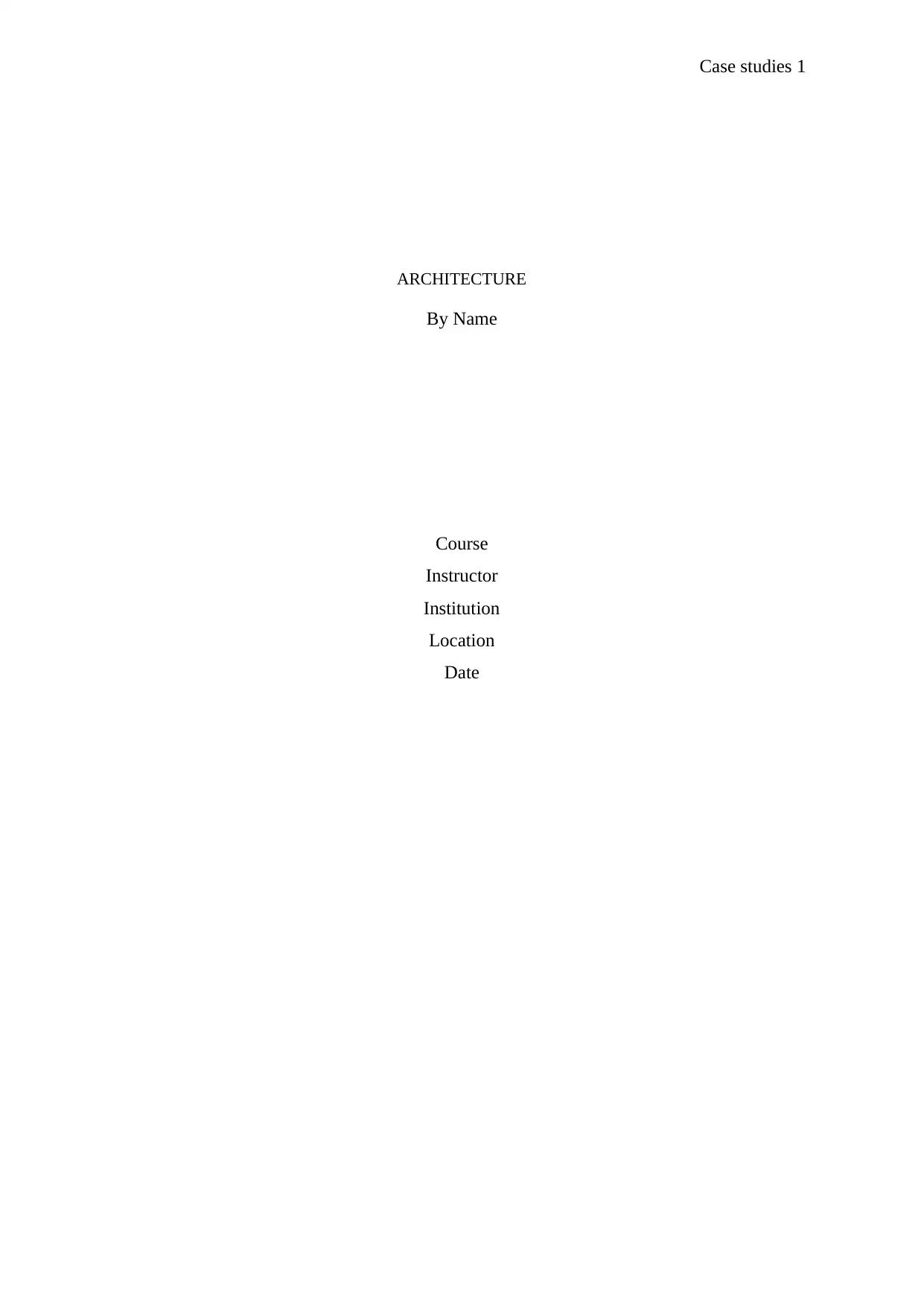
Case studies 1
ARCHITECTURE
By Name
Course
Instructor
Institution
Location
Date
ARCHITECTURE
By Name
Course
Instructor
Institution
Location
Date
Secure Best Marks with AI Grader
Need help grading? Try our AI Grader for instant feedback on your assignments.
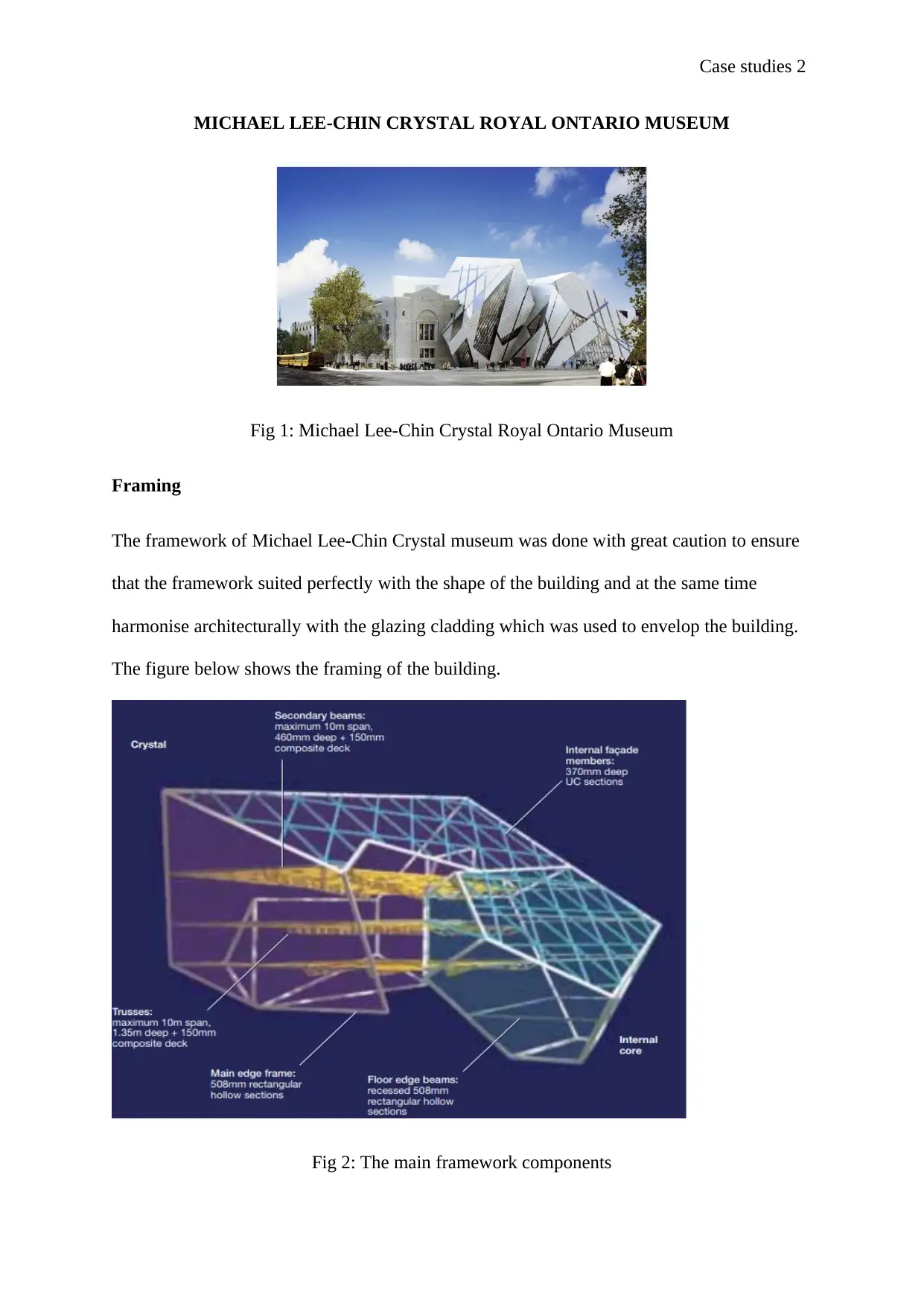
Case studies 2
MICHAEL LEE-CHIN CRYSTAL ROYAL ONTARIO MUSEUM
Fig 1: Michael Lee-Chin Crystal Royal Ontario Museum
Framing
The framework of Michael Lee-Chin Crystal museum was done with great caution to ensure
that the framework suited perfectly with the shape of the building and at the same time
harmonise architecturally with the glazing cladding which was used to envelop the building.
The figure below shows the framing of the building.
Fig 2: The main framework components
MICHAEL LEE-CHIN CRYSTAL ROYAL ONTARIO MUSEUM
Fig 1: Michael Lee-Chin Crystal Royal Ontario Museum
Framing
The framework of Michael Lee-Chin Crystal museum was done with great caution to ensure
that the framework suited perfectly with the shape of the building and at the same time
harmonise architecturally with the glazing cladding which was used to envelop the building.
The figure below shows the framing of the building.
Fig 2: The main framework components
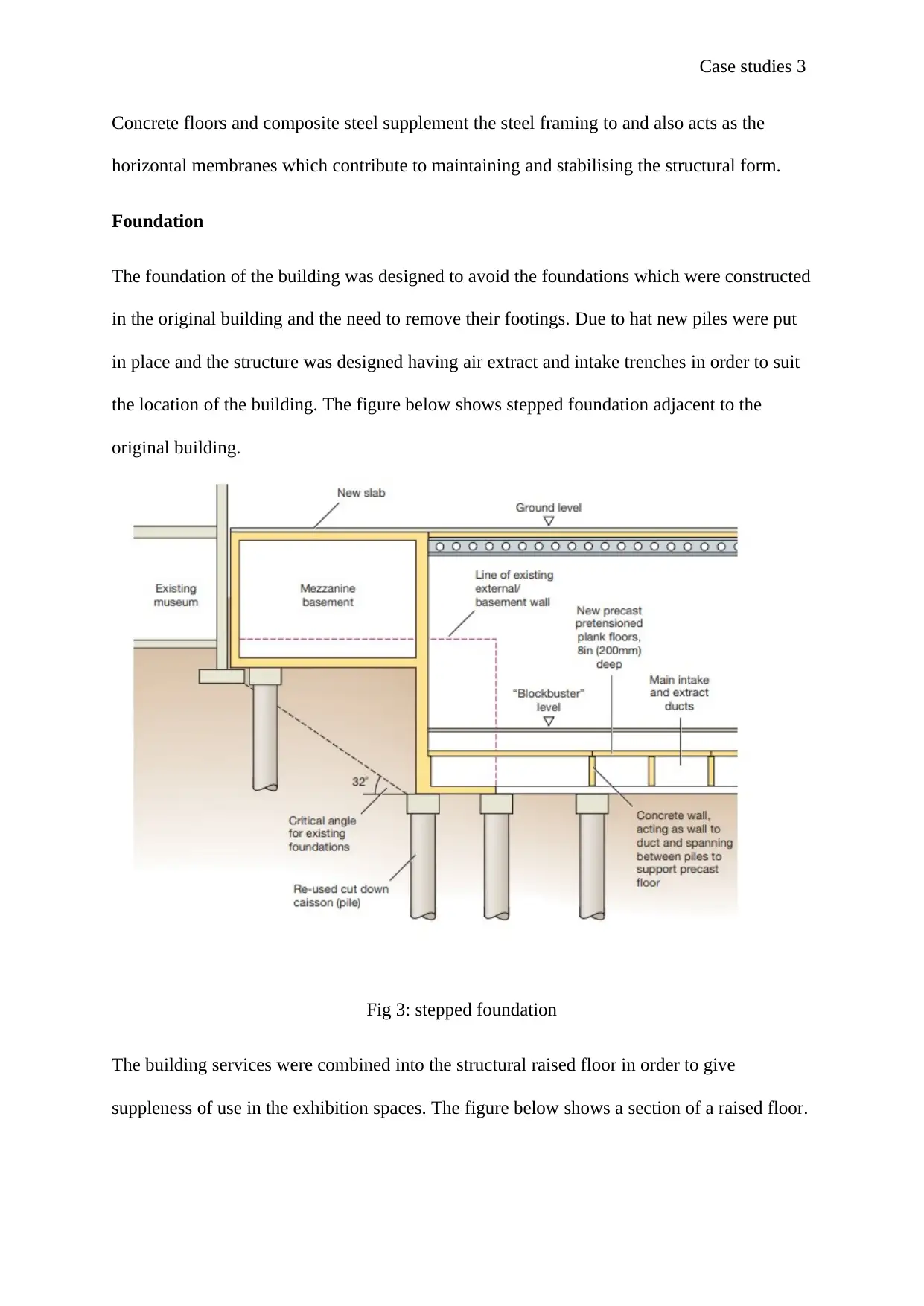
Case studies 3
Concrete floors and composite steel supplement the steel framing to and also acts as the
horizontal membranes which contribute to maintaining and stabilising the structural form.
Foundation
The foundation of the building was designed to avoid the foundations which were constructed
in the original building and the need to remove their footings. Due to hat new piles were put
in place and the structure was designed having air extract and intake trenches in order to suit
the location of the building. The figure below shows stepped foundation adjacent to the
original building.
Fig 3: stepped foundation
The building services were combined into the structural raised floor in order to give
suppleness of use in the exhibition spaces. The figure below shows a section of a raised floor.
Concrete floors and composite steel supplement the steel framing to and also acts as the
horizontal membranes which contribute to maintaining and stabilising the structural form.
Foundation
The foundation of the building was designed to avoid the foundations which were constructed
in the original building and the need to remove their footings. Due to hat new piles were put
in place and the structure was designed having air extract and intake trenches in order to suit
the location of the building. The figure below shows stepped foundation adjacent to the
original building.
Fig 3: stepped foundation
The building services were combined into the structural raised floor in order to give
suppleness of use in the exhibition spaces. The figure below shows a section of a raised floor.
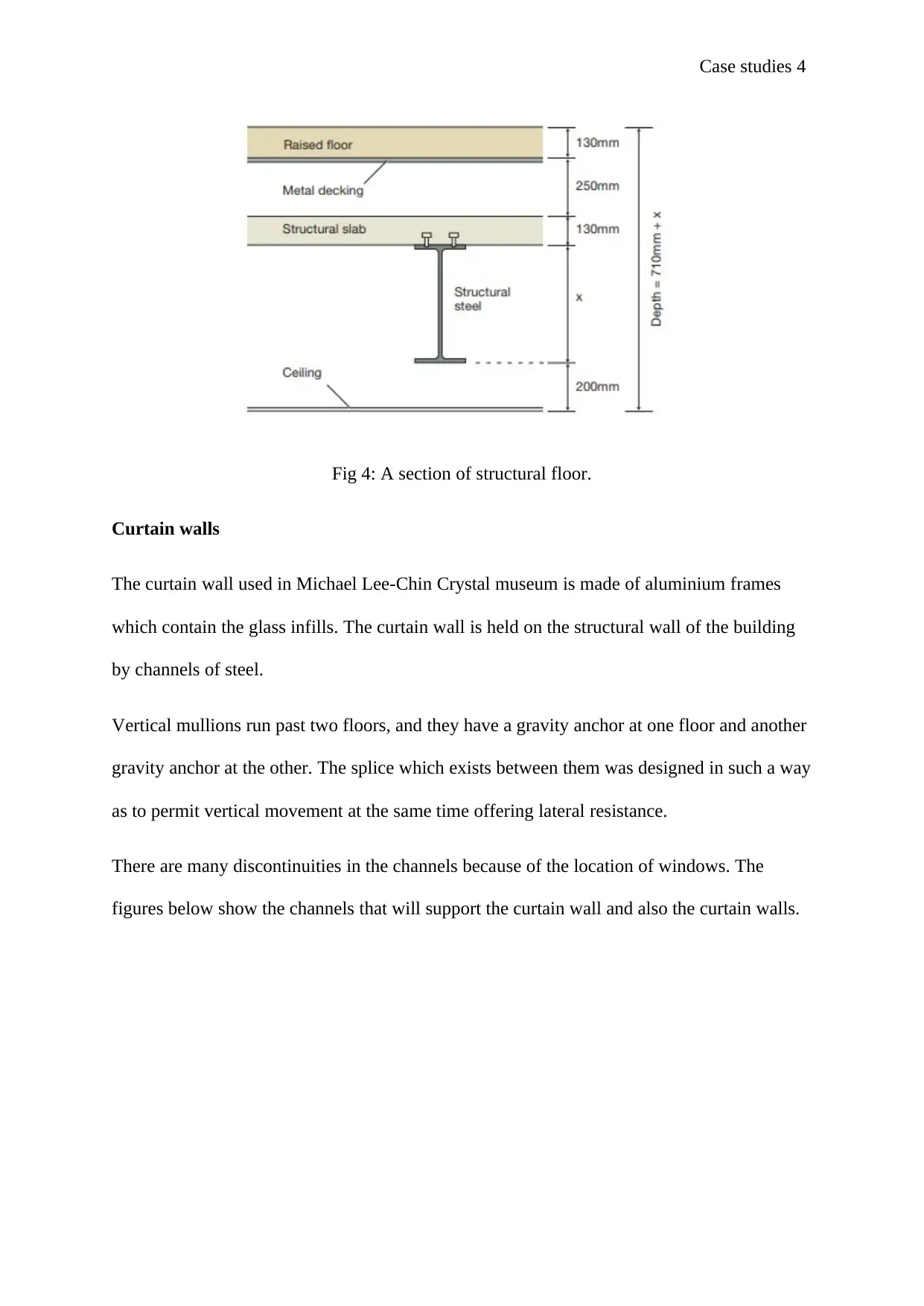
Case studies 4
Fig 4: A section of structural floor.
Curtain walls
The curtain wall used in Michael Lee-Chin Crystal museum is made of aluminium frames
which contain the glass infills. The curtain wall is held on the structural wall of the building
by channels of steel.
Vertical mullions run past two floors, and they have a gravity anchor at one floor and another
gravity anchor at the other. The splice which exists between them was designed in such a way
as to permit vertical movement at the same time offering lateral resistance.
There are many discontinuities in the channels because of the location of windows. The
figures below show the channels that will support the curtain wall and also the curtain walls.
Fig 4: A section of structural floor.
Curtain walls
The curtain wall used in Michael Lee-Chin Crystal museum is made of aluminium frames
which contain the glass infills. The curtain wall is held on the structural wall of the building
by channels of steel.
Vertical mullions run past two floors, and they have a gravity anchor at one floor and another
gravity anchor at the other. The splice which exists between them was designed in such a way
as to permit vertical movement at the same time offering lateral resistance.
There are many discontinuities in the channels because of the location of windows. The
figures below show the channels that will support the curtain wall and also the curtain walls.
Secure Best Marks with AI Grader
Need help grading? Try our AI Grader for instant feedback on your assignments.
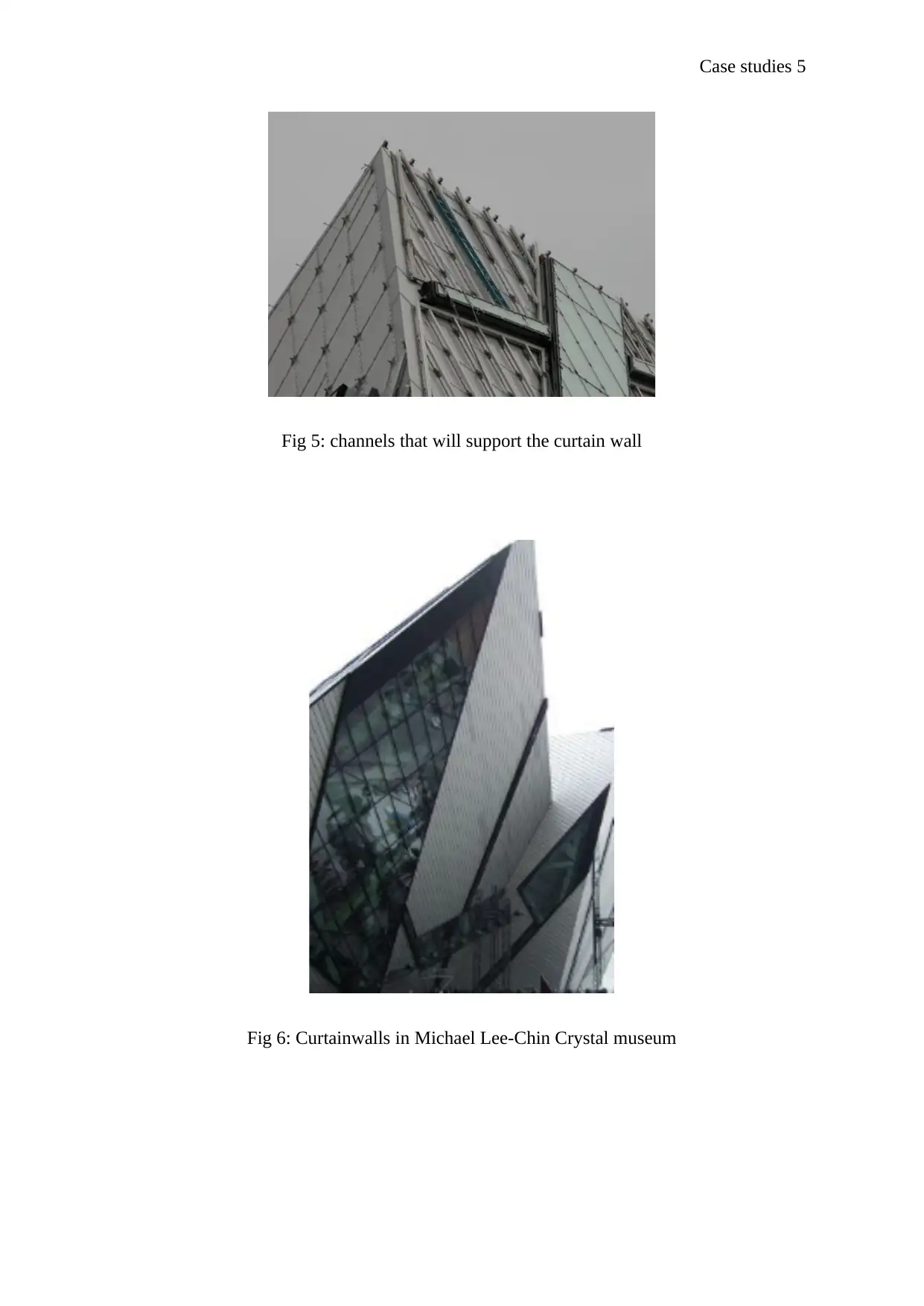
Case studies 5
Fig 5: channels that will support the curtain wall
Fig 6: Curtainwalls in Michael Lee-Chin Crystal museum
Fig 5: channels that will support the curtain wall
Fig 6: Curtainwalls in Michael Lee-Chin Crystal museum
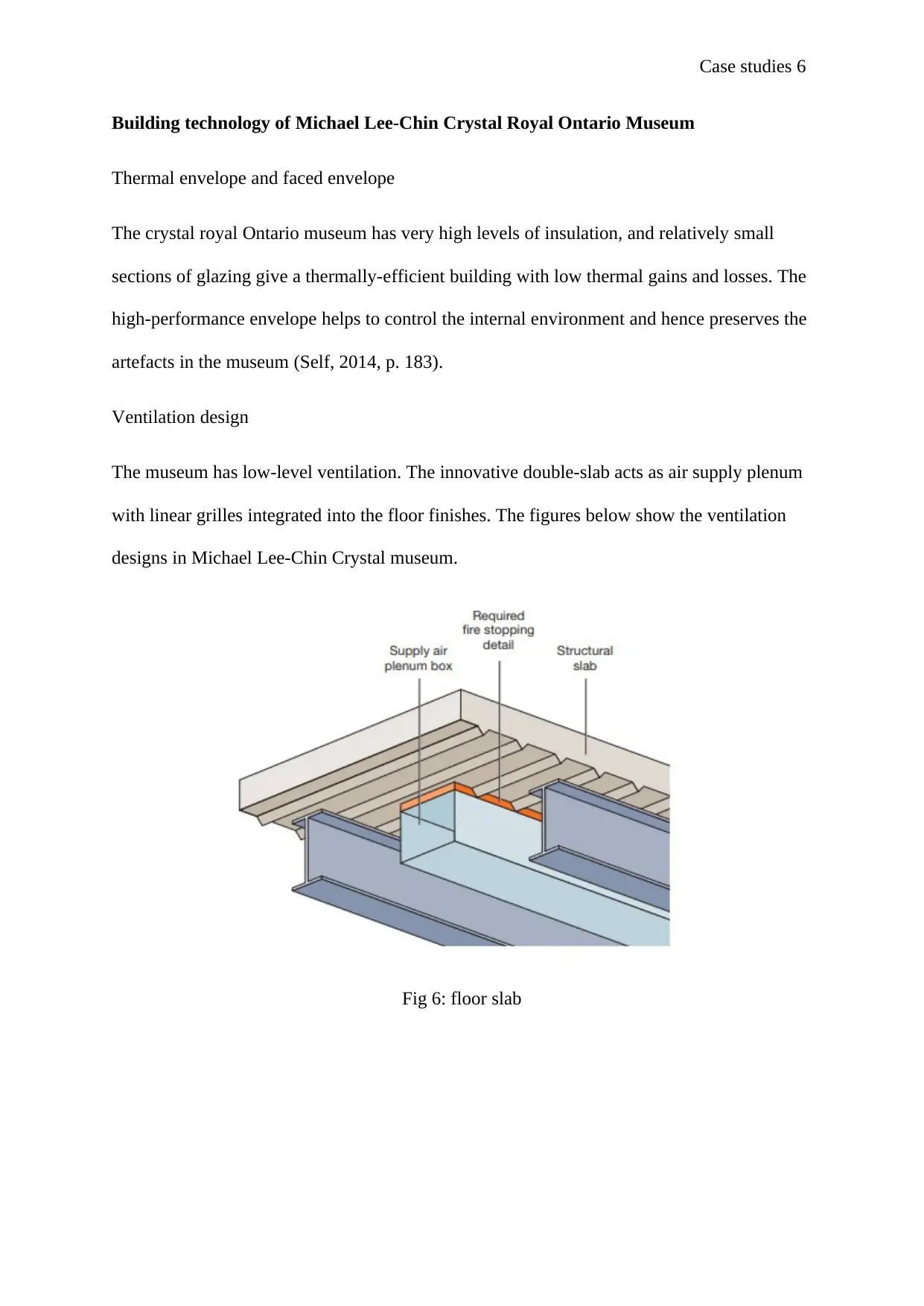
Case studies 6
Building technology of Michael Lee-Chin Crystal Royal Ontario Museum
Thermal envelope and faced envelope
The crystal royal Ontario museum has very high levels of insulation, and relatively small
sections of glazing give a thermally-efficient building with low thermal gains and losses. The
high-performance envelope helps to control the internal environment and hence preserves the
artefacts in the museum (Self, 2014, p. 183).
Ventilation design
The museum has low-level ventilation. The innovative double-slab acts as air supply plenum
with linear grilles integrated into the floor finishes. The figures below show the ventilation
designs in Michael Lee-Chin Crystal museum.
Fig 6: floor slab
Building technology of Michael Lee-Chin Crystal Royal Ontario Museum
Thermal envelope and faced envelope
The crystal royal Ontario museum has very high levels of insulation, and relatively small
sections of glazing give a thermally-efficient building with low thermal gains and losses. The
high-performance envelope helps to control the internal environment and hence preserves the
artefacts in the museum (Self, 2014, p. 183).
Ventilation design
The museum has low-level ventilation. The innovative double-slab acts as air supply plenum
with linear grilles integrated into the floor finishes. The figures below show the ventilation
designs in Michael Lee-Chin Crystal museum.
Fig 6: floor slab
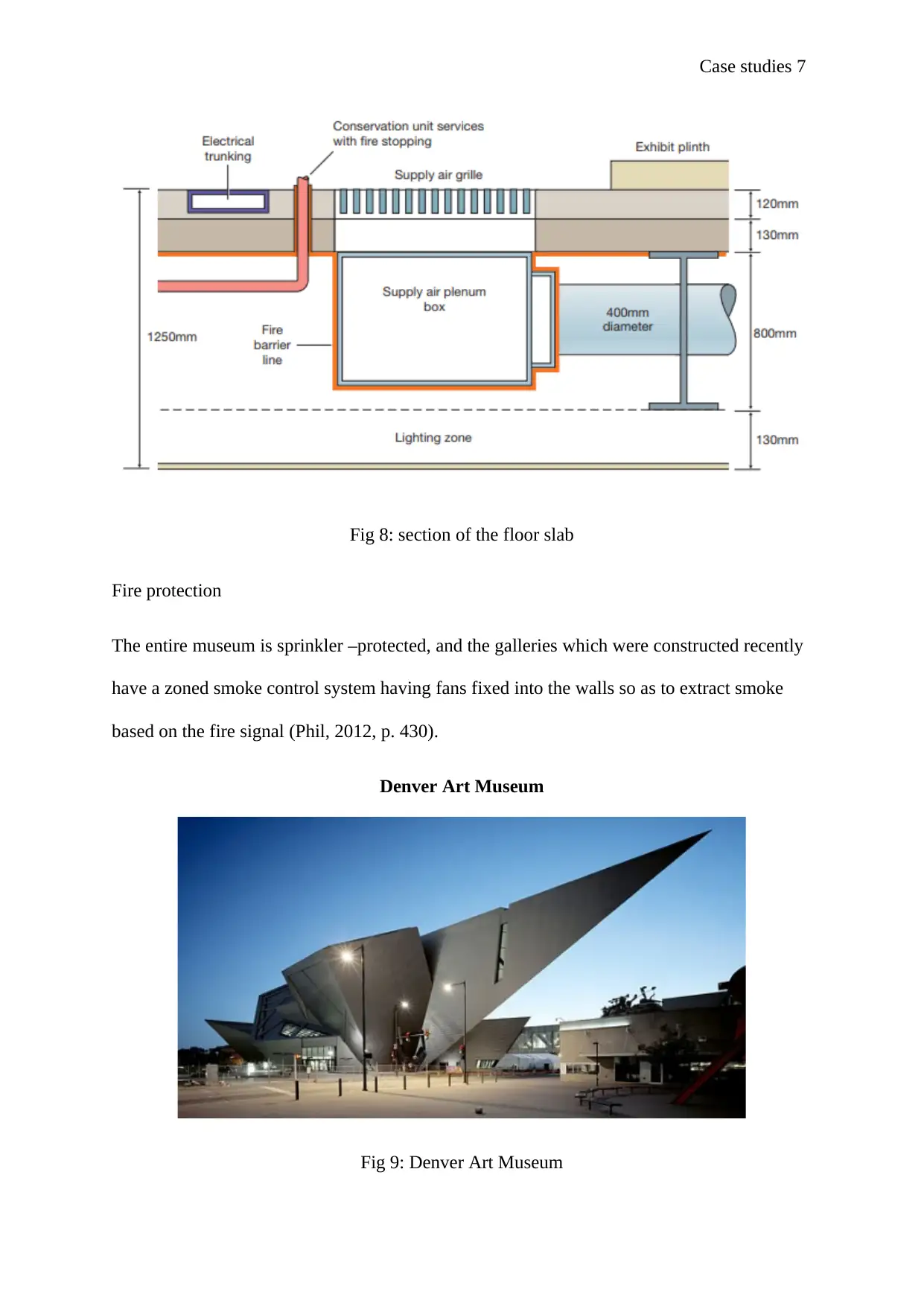
Case studies 7
Fig 8: section of the floor slab
Fire protection
The entire museum is sprinkler –protected, and the galleries which were constructed recently
have a zoned smoke control system having fans fixed into the walls so as to extract smoke
based on the fire signal (Phil, 2012, p. 430).
Denver Art Museum
Fig 9: Denver Art Museum
Fig 8: section of the floor slab
Fire protection
The entire museum is sprinkler –protected, and the galleries which were constructed recently
have a zoned smoke control system having fans fixed into the walls so as to extract smoke
based on the fire signal (Phil, 2012, p. 430).
Denver Art Museum
Fig 9: Denver Art Museum
Paraphrase This Document
Need a fresh take? Get an instant paraphrase of this document with our AI Paraphraser
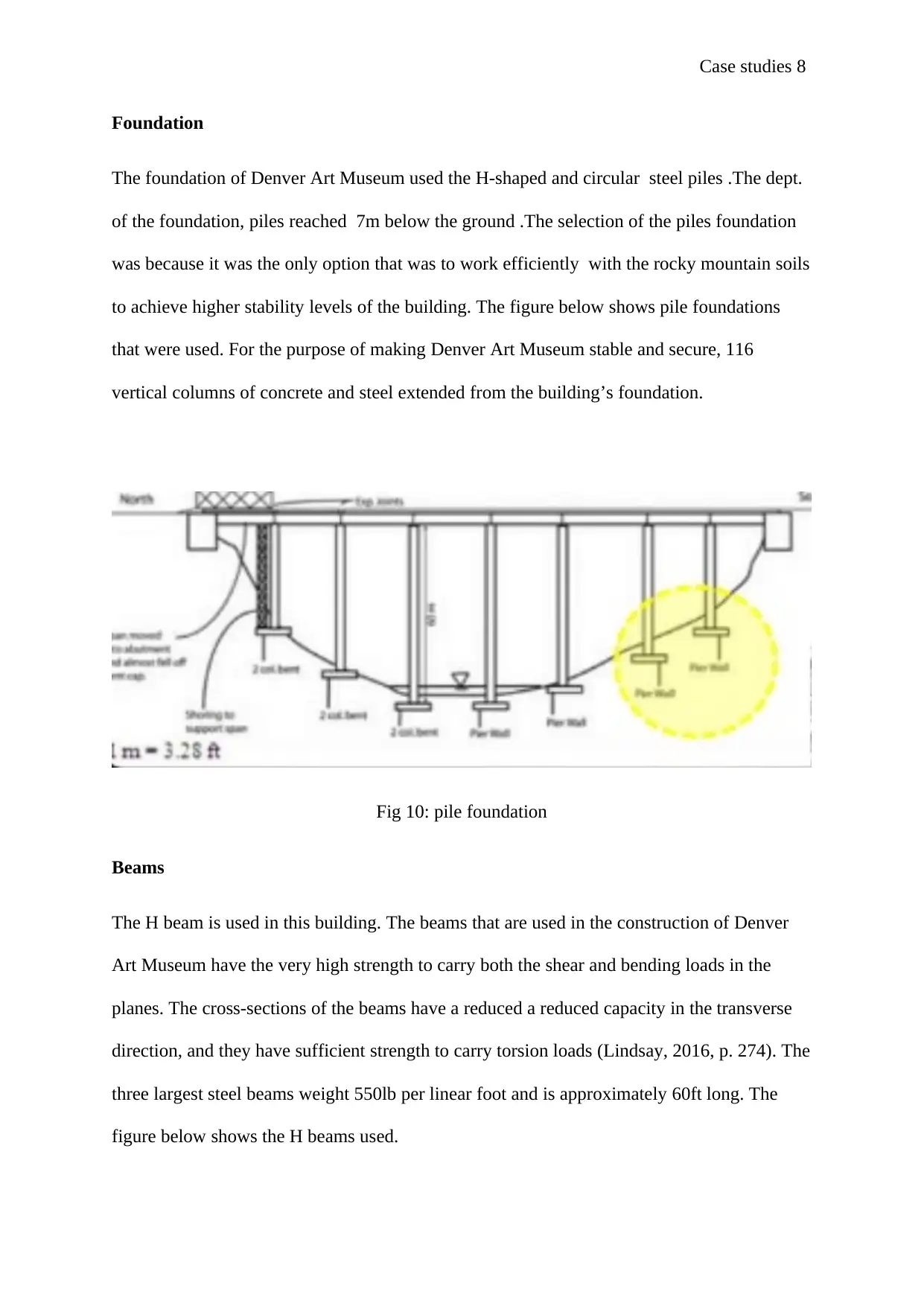
Case studies 8
Foundation
The foundation of Denver Art Museum used the H-shaped and circular steel piles .The dept.
of the foundation, piles reached 7m below the ground .The selection of the piles foundation
was because it was the only option that was to work efficiently with the rocky mountain soils
to achieve higher stability levels of the building. The figure below shows pile foundations
that were used. For the purpose of making Denver Art Museum stable and secure, 116
vertical columns of concrete and steel extended from the building’s foundation.
Fig 10: pile foundation
Beams
The H beam is used in this building. The beams that are used in the construction of Denver
Art Museum have the very high strength to carry both the shear and bending loads in the
planes. The cross-sections of the beams have a reduced a reduced capacity in the transverse
direction, and they have sufficient strength to carry torsion loads (Lindsay, 2016, p. 274). The
three largest steel beams weight 550lb per linear foot and is approximately 60ft long. The
figure below shows the H beams used.
Foundation
The foundation of Denver Art Museum used the H-shaped and circular steel piles .The dept.
of the foundation, piles reached 7m below the ground .The selection of the piles foundation
was because it was the only option that was to work efficiently with the rocky mountain soils
to achieve higher stability levels of the building. The figure below shows pile foundations
that were used. For the purpose of making Denver Art Museum stable and secure, 116
vertical columns of concrete and steel extended from the building’s foundation.
Fig 10: pile foundation
Beams
The H beam is used in this building. The beams that are used in the construction of Denver
Art Museum have the very high strength to carry both the shear and bending loads in the
planes. The cross-sections of the beams have a reduced a reduced capacity in the transverse
direction, and they have sufficient strength to carry torsion loads (Lindsay, 2016, p. 274). The
three largest steel beams weight 550lb per linear foot and is approximately 60ft long. The
figure below shows the H beams used.
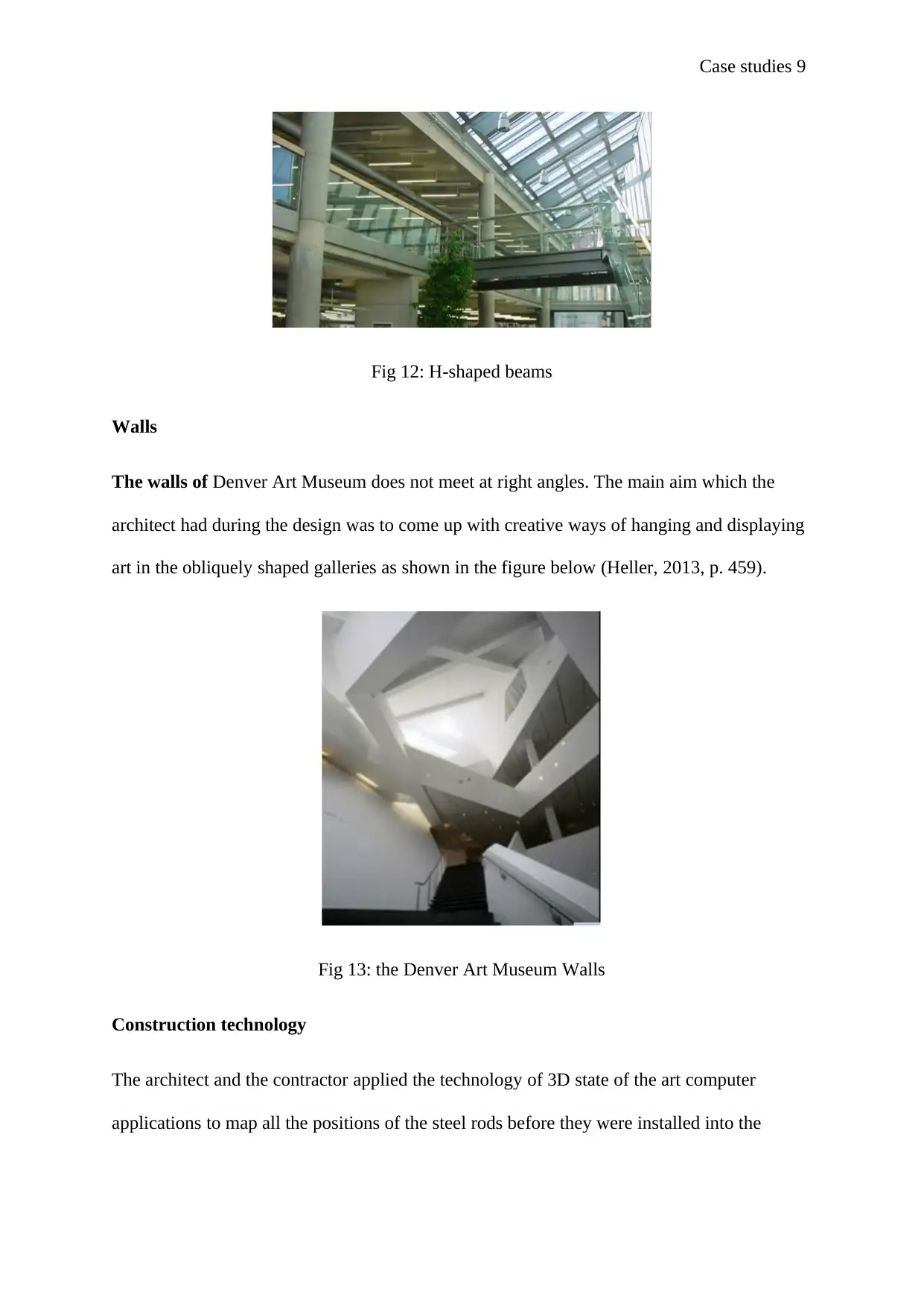
Case studies 9
Fig 12: H-shaped beams
Walls
The walls of Denver Art Museum does not meet at right angles. The main aim which the
architect had during the design was to come up with creative ways of hanging and displaying
art in the obliquely shaped galleries as shown in the figure below (Heller, 2013, p. 459).
Fig 13: the Denver Art Museum Walls
Construction technology
The architect and the contractor applied the technology of 3D state of the art computer
applications to map all the positions of the steel rods before they were installed into the
Fig 12: H-shaped beams
Walls
The walls of Denver Art Museum does not meet at right angles. The main aim which the
architect had during the design was to come up with creative ways of hanging and displaying
art in the obliquely shaped galleries as shown in the figure below (Heller, 2013, p. 459).
Fig 13: the Denver Art Museum Walls
Construction technology
The architect and the contractor applied the technology of 3D state of the art computer
applications to map all the positions of the steel rods before they were installed into the
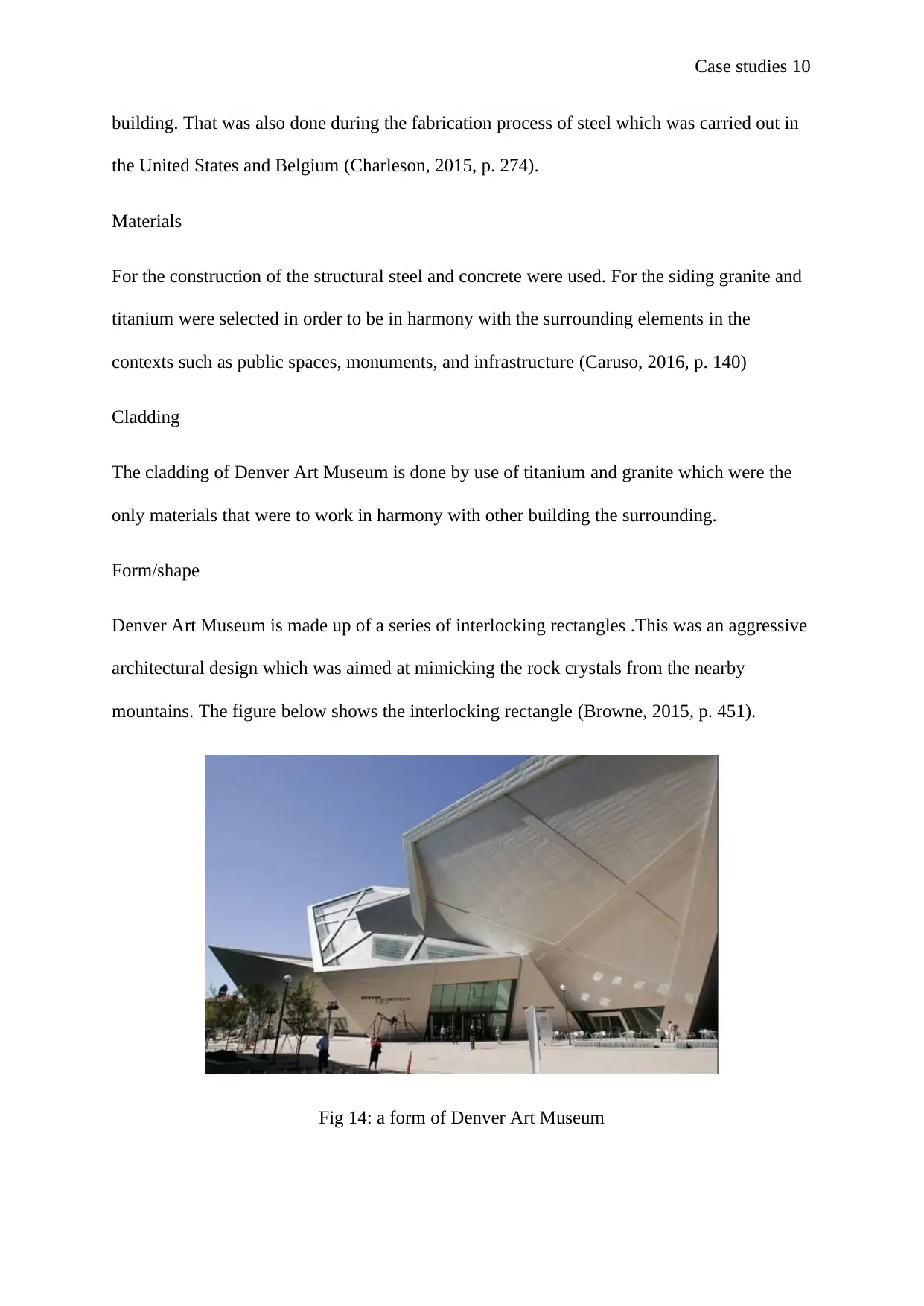
Case studies 10
building. That was also done during the fabrication process of steel which was carried out in
the United States and Belgium (Charleson, 2015, p. 274).
Materials
For the construction of the structural steel and concrete were used. For the siding granite and
titanium were selected in order to be in harmony with the surrounding elements in the
contexts such as public spaces, monuments, and infrastructure (Caruso, 2016, p. 140)
Cladding
The cladding of Denver Art Museum is done by use of titanium and granite which were the
only materials that were to work in harmony with other building the surrounding.
Form/shape
Denver Art Museum is made up of a series of interlocking rectangles .This was an aggressive
architectural design which was aimed at mimicking the rock crystals from the nearby
mountains. The figure below shows the interlocking rectangle (Browne, 2015, p. 451).
Fig 14: a form of Denver Art Museum
building. That was also done during the fabrication process of steel which was carried out in
the United States and Belgium (Charleson, 2015, p. 274).
Materials
For the construction of the structural steel and concrete were used. For the siding granite and
titanium were selected in order to be in harmony with the surrounding elements in the
contexts such as public spaces, monuments, and infrastructure (Caruso, 2016, p. 140)
Cladding
The cladding of Denver Art Museum is done by use of titanium and granite which were the
only materials that were to work in harmony with other building the surrounding.
Form/shape
Denver Art Museum is made up of a series of interlocking rectangles .This was an aggressive
architectural design which was aimed at mimicking the rock crystals from the nearby
mountains. The figure below shows the interlocking rectangle (Browne, 2015, p. 451).
Fig 14: a form of Denver Art Museum
Secure Best Marks with AI Grader
Need help grading? Try our AI Grader for instant feedback on your assignments.
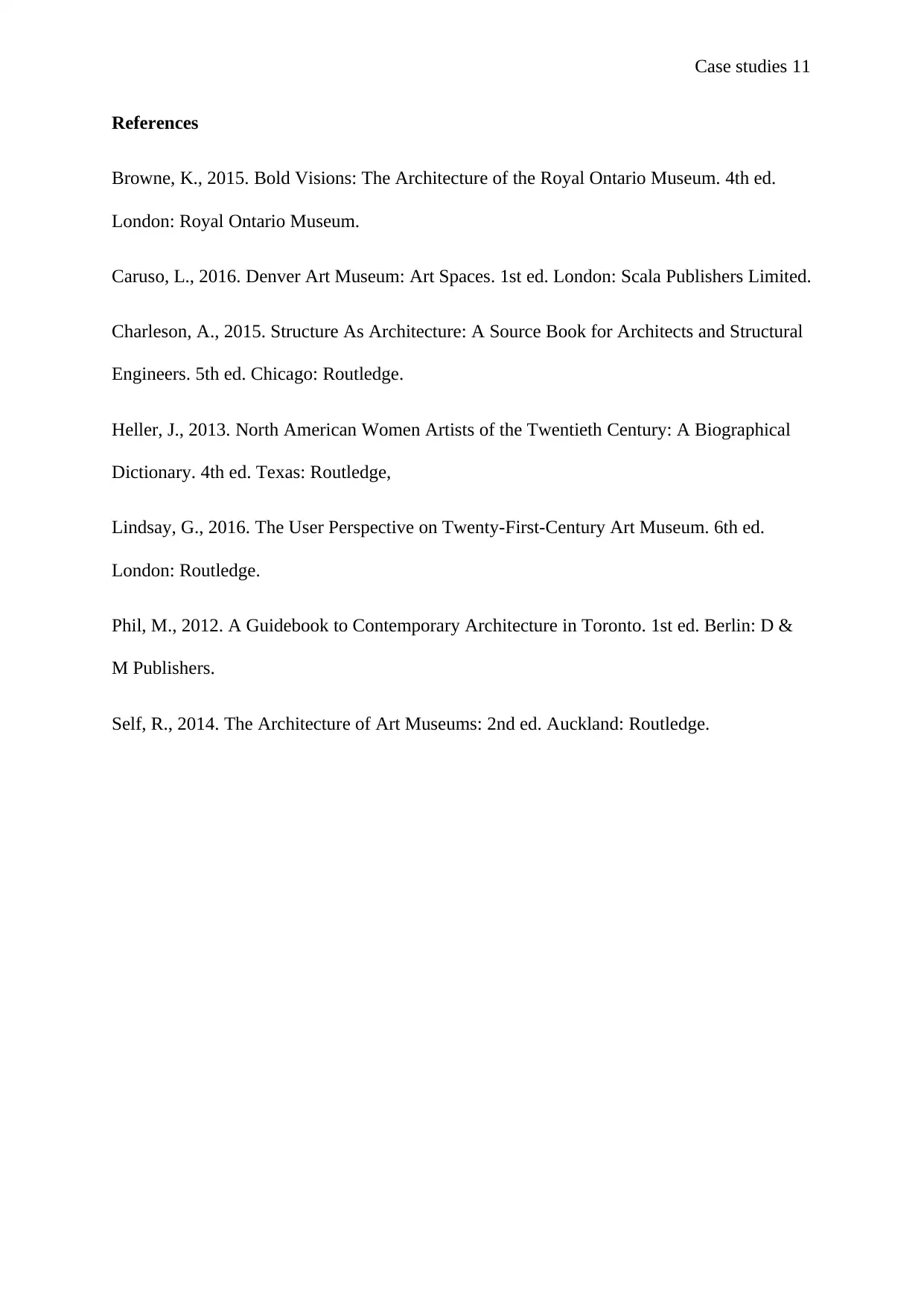
Case studies 11
References
Browne, K., 2015. Bold Visions: The Architecture of the Royal Ontario Museum. 4th ed.
London: Royal Ontario Museum.
Caruso, L., 2016. Denver Art Museum: Art Spaces. 1st ed. London: Scala Publishers Limited.
Charleson, A., 2015. Structure As Architecture: A Source Book for Architects and Structural
Engineers. 5th ed. Chicago: Routledge.
Heller, J., 2013. North American Women Artists of the Twentieth Century: A Biographical
Dictionary. 4th ed. Texas: Routledge,
Lindsay, G., 2016. The User Perspective on Twenty-First-Century Art Museum. 6th ed.
London: Routledge.
Phil, M., 2012. A Guidebook to Contemporary Architecture in Toronto. 1st ed. Berlin: D &
M Publishers.
Self, R., 2014. The Architecture of Art Museums: 2nd ed. Auckland: Routledge.
References
Browne, K., 2015. Bold Visions: The Architecture of the Royal Ontario Museum. 4th ed.
London: Royal Ontario Museum.
Caruso, L., 2016. Denver Art Museum: Art Spaces. 1st ed. London: Scala Publishers Limited.
Charleson, A., 2015. Structure As Architecture: A Source Book for Architects and Structural
Engineers. 5th ed. Chicago: Routledge.
Heller, J., 2013. North American Women Artists of the Twentieth Century: A Biographical
Dictionary. 4th ed. Texas: Routledge,
Lindsay, G., 2016. The User Perspective on Twenty-First-Century Art Museum. 6th ed.
London: Routledge.
Phil, M., 2012. A Guidebook to Contemporary Architecture in Toronto. 1st ed. Berlin: D &
M Publishers.
Self, R., 2014. The Architecture of Art Museums: 2nd ed. Auckland: Routledge.

Case studies 12
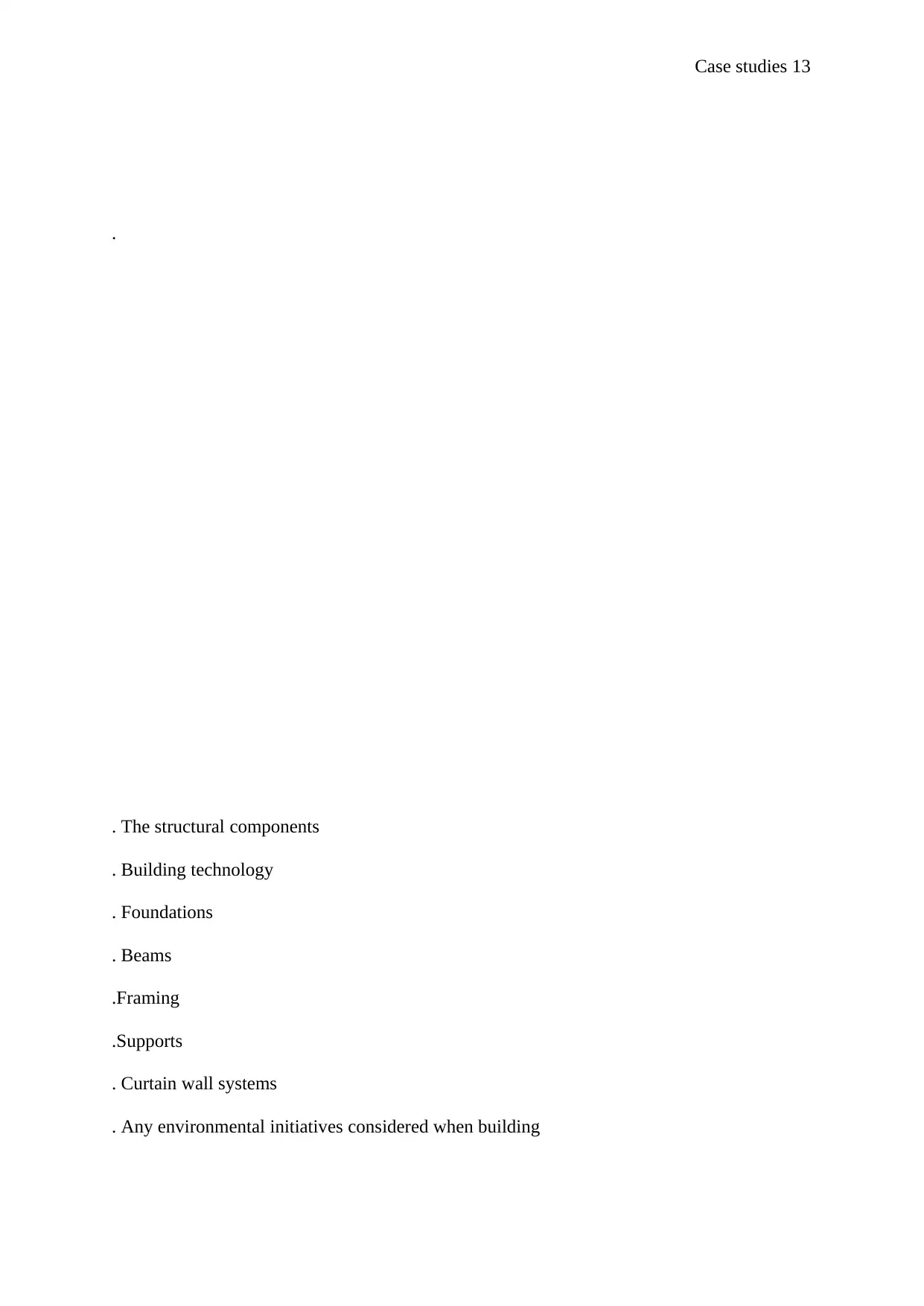
Case studies 13
.
. The structural components
. Building technology
. Foundations
. Beams
.Framing
.Supports
. Curtain wall systems
. Any environmental initiatives considered when building
.
. The structural components
. Building technology
. Foundations
. Beams
.Framing
.Supports
. Curtain wall systems
. Any environmental initiatives considered when building
1 out of 13
Your All-in-One AI-Powered Toolkit for Academic Success.
+13062052269
info@desklib.com
Available 24*7 on WhatsApp / Email
![[object Object]](/_next/static/media/star-bottom.7253800d.svg)
Unlock your academic potential
© 2024 | Zucol Services PVT LTD | All rights reserved.